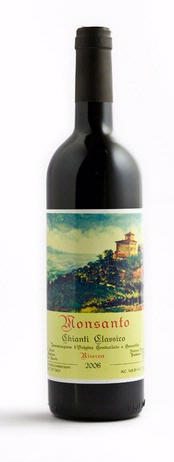Castello di Monsanto, Chianti Classico Riserva 2012 and Chianti Classico Riserva Il Poggio 2010 (MW Imports USA, $25 and $55): The first case of wine that I ever purchased was a Monsanto Chianti Classico Riserva, specifically the 1971 Il Poggio vineyard, from what was at the time a fairly new Tuscan estate. In wine terms, I suppose that’s like a first kiss: Even as other flames come and go, you remain forever linked to that  wine that elicited your first full-case commitment. With the release of the 2012 Chianti Classico Riserva, Monsanto is now celebrating half a century of grape growing and wine production. Luckily for me, my old flame continues to impress me.
wine that elicited your first full-case commitment. With the release of the 2012 Chianti Classico Riserva, Monsanto is now celebrating half a century of grape growing and wine production. Luckily for me, my old flame continues to impress me.
When Aldo Bianchi, a native of the Tuscan town of San Gimignano, purchased the Castello di Monsanto estate in 1960, his son Fabrizio recognized the property’s centuries-old viticultural heritage and its potential for fine wine. With wife Giuliana, Fabrizio developed the vineyards and reconstructed the estate’s farmhouses for the modern-era production of wine. He brought innovation after innovation. In 1962, he created the first single-vineyard Chianti Classico, Il Poggio; in 1968, he defied regulations by eliminating white grape varieties from his red wine; also in 1968 he ceased the typical practice of retaining the stalks for fermentation and discontinued the “governo,” a re-fermentation technique using later-harvested grapes to create an early-drinking style; and he produced an all-Sangiovese wine. These and numerous other changes were intended to lift the wines of Monsanto to the level of age-worthy fine wine. Today, Fabrizio and his daughter, Laura, work side by side in running the property, which now includes a 300-meter underground tunnel for aging the wines.
Even as early as the 1971 vintage, Monsanto was considered a force to be reckoned with among Tuscan wines. Riservas from the Il Poggio vineyard, in particular, were firmer in structure and more concentrated than their peers, with singular expression of Sangiovese character. In my tasting circles, the 1975 Il Poggio earned the nickname of “the Tuscan Chateau Latour” for its commanding structure and age-worthiness.
Castello di Monsanto’s Riservas — both Il Poggio and the “regular” Riserva — are 90 percent Sangiovese, with the remaining 10 percent derived from the native grapes Canaiolo and Colorino. Of the winery’s 178 acres of vines, more than 138 are planted to Sangiovese; the clones are those derived from a massale selection from the Il Poggio vineyard, which is to say a mixture of ancient, traditional clones. Il Poggio itself is 13.6 acres in size.
Of the two Riservas, Il Poggio ages longer at the winery and reaches this market later, so that its current release is 2010 compared to 2012 for the other Riserva. Both of these are splendid wines. The 2012, labelled “50th Harvest,” is fragrant with red cherry and floral notes on the nose, and similar flavors, along with spicy, earthy and mineral notes in the mouth. It’s medium-bodied but verging toward full-bodied, properly dry for Chianti Classico, and moderately tannic, as Sangiovese is. I admire its balance: Its acid, tannin, alcohol and nicely-concentrated fruit all beautifully integrated. I admire its classic Chianti structure: a bit light on the entry compared to red wines made in the New World model, but with an intensity that builds to a strong mid-palate expression and an even stronger rear-palate. For me, that’s the mark of Chianti Classico.
The 2010 Chianti Classico Riserva Il Poggio is the child of not only a single, superior vineyard but also a considerably finer vintage than the 2012 Riserva. Everything about this wine is amped-up — its aromatic profile, its intensity, its concentration, its tannic structure, and its age-worthiness — but all of this within the conservative context of Chianti Classico. Dense, dark cherry notes mark the aroma and flavor, for example, and a richness of fruit character (especially after aeration) combines with soft but abundant tannins to create a velvety texture. In the finish, complexities of mineral and spice emerge. The tannins in this wine are significant, but the balance of fruit to tannin indicates to me that the wine is merely growing out of its awkward youth and promises a grand future. It’s interesting to note that this wine aged only in gentler, more softening 500-liter tonneaux of French oak compared to the 2012 Riserva, which ages in a combination of barriques and tonneaux; one-third of the tonneaux for Il Poggio were new, however, which was not the case for any of the barriques in the 2012.
For cellaring, the 2010 Il Poggio is a no-brainer, even if it is delicious now with aeration. The 2012 Riserva, on the other hand, is a delight right out of the bottle. But it, too, can age, and I believe it will develop for ten years with good storage. How many $25 wines can deliver like that?
2012 Riserva, 91 Points
2010 Il Poggio, 93 Points
